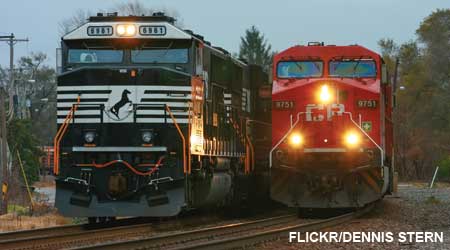Stay updated on news, articles and information for the rail industry
July 2009
Rail News: Rail Industry
Integrating the DM&E is a key cog in Canadian Pacific’s plan to reposition capacity ahead of traffic demand shifts
In front of Canadian Pacific’s headquarters, steam locomotive No. 29 is tastefully displayed. Built in 1887 and retired from operations in 1960 as CP’s last steam engine, No. 29 marks the Class I’s switch to diesel locomotives.
The engine symbolizes something CP has repeatedly done since its 1881 founding: adapt to changing business conditions. The Class I wouldn’t have made the transition from Canada’s first transcontinental railway to a major long-distance passenger-rail provider to the nation’s second-largest freight railroad without making adjustments along the way.
Now, as the recession remains in full swing, CP is trying to adapt to rapidly changing Canadian and U.S. market conditions, such as a shift away from what had been historical supply-chain relationships and transportation patterns.
And the Class I is banking heavily on the integration of the Dakota, Minnesota & Eastern Railroad (DM&E) — which will provide the Class I access to several key U.S. Midwest markets for agricultural products, coal and ethanol — to accommodate a good portion of those shifts.
CP is undergoing a “reinvention,” as President and Chief Executive Officer Fred Green describes it, aimed at repositioning capacity and redesigning operations based on transportation patterns top execs are convinced will develop post-recession.
Senior executives are certain fewer Chinese imports and raw material exports will flow into and out of Canadian West Coast ports, Canadian and U.S. grain markets will be robust, and sluggish Canadian metallurgical coal and potash traffic eventually will rebound.
By ensuring intermodal and bulk traffic capacity is in place where demand will strengthen, CP will be able to sustain traffic, keeping carloads at high levels for eight weeks or longer and avoiding one-week jumps and prolonged slumps, senior execs believe.
“We’re being methodical in implementing game-changing, sustainable improvements that will better position us to serve customers,” says Senior Vice President of Operations Brock Winter.
And, so, position CP as a more competitive rail carrier.
During interviews conducted at CP’s Calgary, Alberta, HQ in late May, Winter and two other senior execs talked at length with Progressive Railroading about ongoing improvements, which also include efforts to redesign grain and international intermodal pipelines, consolidate facilities, and operate longer and more distributed-power trains.
Aside from incorporating the DM&E, CP is making adjustments every Class I needs to make to be ready to meet post-recession demands. To ensure they’re players in what CP senior execs are calling the “new economic reality,” all Class Is are trying to reposition capacity.
CP already is better prepared to face the new reality in one key business segment: export grain.
In mid-2008, the Class I launched efforts to improve the export grain pipeline by working with its supply-chain partners to redesign transportation flows, says Winter.
Pull vs. push
To reduce cycle times, the parties transitioned from a system that called for pushing traffic to the Port of Vancouver, British Columbia, based on western prairie elevator demand to one that calls for pulling traffic to the port based on vessel arrivals and port capacity, he says.
By 2008’s end, CP already had reduced export grain cycle times by more than 30 percent and moved more tonnage with fewer assets. The Class I also reduced variable costs and train miles.
“It’s all about asset utilization,” says Winter. “You look at fixed costs, like elevators, and use more assets on an even-flow basis.”
To implement the “pull vs. push model,” there had to be give and take from all supply-chain stakeholders, such as some parties agreeing to operate 24/7, he says.
“A little bit on all ends makes a big difference,” says Winter.
Now, CP has reduced cycle times to 11 or 12.5 days compared with the 15- or 17-day cycles common prior to the model’s implementation, he says.
In addition, the Class I as of last month remained on pace in the current crop year’s third quarter to set a full crop-year grain movement record, with wheat, durum and canola driving volume increases.
Plus, the railroad in April reached a 10-year high for monthly empty order fulfillment.
CP has improved export grain transit times and rail-car availability to the point that the Canadian Wheat Board (CWB) earlier this year diverted more tonnage to the Class I, says RBC Capital Markets analyst Walter Spracklin.
Historically, the CWB splits export grain tonnage evenly between CP and CN; now, the percentage of tonnage is 60/40 in favor of CP and the board might divert even more traffic to the Class I because of its improved service performance, he says.
CP plans to continue tweaking the model through 2009 and cycle times will remain on the decline, says Winter.
In the meantime, the Class I plans to apply the pull vs. push model to its export intermodal business, such as international containers moving from the Vancouver port to Toronto.
CP could reduce export intermodal cycle times from 20 days to 10 days primarily by reducing port switching operations, which account for 50 percent of down time, says Winter, adding that the railroad aims to balance inbound and outbound trains.
The Class I also plans to apply the model to its U.S. grain pipeline.
DM&E: An ‘excellent fit’
That business segment received a big boost in October 2008, when CP assumed control of the DM&E, the largest U.S. regional and only Class II railroad that interchanges with all seven Class Is. Acquired by CP in late 2007, the DM&E operates more than 2,500 miles of track in Iowa, Illinois, Missouri, Minnesota, Nebraska, South Dakota, Wisconsin and Wyoming, which include several busy grain regions as well as access to Chicago, the Twin Cities and Kansas City, Mo.
“We’re what I call an ‘agri-products franchise,’ and we’ve added the DM&E to make it stronger,” says Winter.
The regional is an excellent fit with CP based on geography and the Class I’s book of business, adds SVP of Strategy and Yield Jane O’Hagan.
The tightness of the fit will take a while to gauge because CP is taking a gradual approach to incorporating the DM&E. Although financial systems have been integrated, it might take six months or longer to integrate operating systems, such as crew and train management systems.
The full integration likely won’t be completed until November or December.
The “methodical vs. flash” cutover will help CP avoid operational problems that occurred after other mergers, such as the Conrail integration, says Executive VP and Chief Financial Officer Kathryn McQuade.
“If there’s a hiccup, we can hold up and fix it,” she says.
In addition, CP will gain time to consider ways to streamline operations and “talk about opportunities we can take advantage of,” says O’Hagan, such as traffic on the former Iowa, Chicago & Eastern Railroad’s (IC&E) K.C.-to-Chicago gateway, a key east-west corridor the Class I lacked in the United States.
After the integration’s complete, the DM&E will retain its identity as a CP subsidiary that incorporates the network of former sister railroad the IC&E.
A successful integration hinges on what senior execs have identified as the three S’s: synergies, systems and safety.
In terms of synergies, CP and DM&E execs are sharing market knowledge, says McQuade.
“They’ve already made lemonade from lemons — they know marketing in their region,” she says. “We’re not just telling them that they’re a small railroad and here’s what they should do.”
Seeking a safe road
However, CP is taking charge with safety, which is the “foundation to the rest of the integration,” says McQuade, adding that the DM&E will have safety processes and rules akin to a Class I.
A safety integration plan that CP submitted to the Surface Transportation Board (STB) as part of the merger approval process is guiding how the Class I is applying its safety principles at the regional. For example, CP is implementing its train accident prevention program and injury reduction plan, and analyzing every incident to determine a root cause
“The DM&E has a good base and understanding of safety, and their people are thirsty for it,” says O’Hagan. “We’re making improvements that people want to see.”
Year-to-date safety metrics through June’s first week show the improvements are taking hold. The DM&E’s ratio of injuries per 200,000 manhours improved 51 percent, train accident frequency ratio improved 45 percent and grade crossing accidents declined 61 percent compared with data from the same 2008 period.
In addition to following through on its safety integration obligation, CP is committed to spending $300 million to upgrade the DM&E’s track.
The work primarily will involve the installation of new rail or high-quality relay rail, says McQuade. The Class I already has installed continuous-welded rail through Rochester, Minn.
“The DM&E has done a good job of upgrading ties and ballast,” says McQuade.
However, it might take five years or longer for CP to complete the track upgrades. The Class I has reined in capital spending of late; earlier this year, the railroad reduced the ’09 capex budget from more than $800 million to between $720 and $740 million.
So far, CP has spent about 8 percent of the $300 million commitment, says McQuade.
“We didn’t say how long we would take to spend it,” she says.
PRB project in limbo
CP also hasn’t committed to any timeframe for advancing the DM&E’s long-proposed Powder River Basin (PRB) line, which CEO Green has described as the icing on the acquisition-deal cake.
Although the project received the STB’s blessing several years ago, CP would need to line up coal contracts, attract a second investor or the involvement of a second party and await public policy changes on coal before the Class I would begin building the line, says McQuade.
“We’re still working the file and still have interest in it,” she says.
Even though the PRB project is on hold and the integration is far from over, the DM&E already has afforded CP several sooner-than-expected efficiency gains, such as a number of locomotives and cars that have come off lease. As part of the acquisition, CP obtained the DM&E’s 150 locomotives and 7,200 cars.
The Class I is trying to score additional efficiencies by repositioning its yard and shop network.
CP is “doing a deep dive” with facilities and might mothball a few, says Winter. The railroad already restructured mechanical shops in Vancouver and southern Ontario, and closed several satellite yard operations — including hump operations at Winnipeg Yard — after redirecting traffic to a more efficient processing yard.
The moves will help the Class I reduce car handlings and centralize tasks, says Winter.
“A lot of this comes from lean management,” he says “Do we need to have as much as we have?”
That question was answered in April in Michigan, when CP opted to reduce its ownership stake in the Detroit River Tunnel Partnership. The deal strengthens CP’s balance sheet and retains a key asset at the same time, McQuade said in a statement issued on April 1.
The Class I reached an agreement with partner Borealis Infrastructure Management Inc. under which CP’s stake dropped from 50 percent to 16.5 percent, but the railroad gained $110 million plus another $22 million based on the tunnel’s future freight volume. The Class I also retained the right to operate and maintain the tunnel.
Under review
Other aspects of operations are under scrutiny, as well.
The railroad is analyzing operating schedules and alternate gateways to determine ways to improve traffic flow. For example, CP might opt to process Chicago-area traffic in Bensenville, Ill., instead of in the Windy City, says Winter.
In addition, the railroad is prepping to operate longer trains and more distributed-power trains to move higher volumes of materials with fewer assets.
Last year, CP — which Winters considers a bulk train and distributed power expert — completed a trial run of a longer potash train with distributed power.
The Class I soon will begin operating additional longer trains, including 224-car grain trains, because of an updated computer program CP booted up last month.
The second version of the Train Area Marshalling (TrAM) system will help tailor longer trains for different regions, such as the flat western prairies or mountainous subdivisions, says Assistant Vice President of Transportation Brad Murphy.
Introduced several years ago, TrAM analyzes every train manifest and helps transportation managers determine how cars can best be marshalled.
The railroad continues to find ways to “size itself” on nearly a weekly basis to meet demand, says Winter.
First-quarter operating metrics show the Class I’s resizing efforts already were making a difference. Average train speed increased by 7 percent; cars on line
decreased by 15 percent; terminal dwell time dropped by 6 percent; train and crew starts declined by 29 percent; and crew utilization improved by more than 20 percent compared with first-quarter 2008 data.
In addition, the railroad stored 16,000 cars and 350 locomotives — predominantly because traffic has decreased, but partly due to efficiency gains.
Change is a comin’
CP has notched additional efficiencies in 2009’s first half because the railroad already had begun to prepare for a tougher business climate in mid-2008, senior execs say. And in fall 2008, CP launched an Execution Excellence for Efficiency initiative, which calls for reducing expenses by $100 million and boosting productivity.
While efforts under the initiative have accelerated and taken hold through 2009, and other adjustments have been made this year, there hasn’t been enough accomplished to drive home stellar second-quarter financial results, senior execs say. But they’re convinced the actions CP has put in motion will lead to better quarters ahead.
If the Class I wasn’t taking those actions, “we’d be concerned,” says RBC Capital Markets’ Spracklin.
He believes the question Green & Co. ultimately will need to answer for shareholders is: Did they correctly anticipate demand shifts and make the right operational adjustments?
Of course, all Class Is need to answer that question while they reposition themselves to serve the post-recession business world.
“As you look at how every railroad is handling their operations in this environment, every railroad is reinventing itself,” says Spracklin.
For now, CP’s senior execs find it encouraging that the Class I is closer to putting the pieces in place that’ll foster a more efficient and well-positioned “scheduled” railway for the long haul.
“CP will not only survive this downturn, but will use these unsettling times to reinvent ourselves yet again to deliver competitive advantages in the long term,” CEO Green told attendees at the Class I’s shareholders meeting May 22 in Vancouver. “I believe that we must ingrain in our company’s culture a capability to be agile, nimble and opportunistic.” 
Keywords
Browse articles on Canadian Pacific DM&E reinvention economy capacityContact Progressive Railroading editorial staff.


 2025 MOW Spending Report: Passenger-rail programs
2025 MOW Spending Report: Passenger-rail programs
 Gardner steps down as Amtrak CEO
Gardner steps down as Amtrak CEO
 Guest comment: Oliver Wyman’s David Hunt
Guest comment: Oliver Wyman’s David Hunt
 Women of Influence in Rail eBook
Women of Influence in Rail eBook
 railPrime
railPrime







